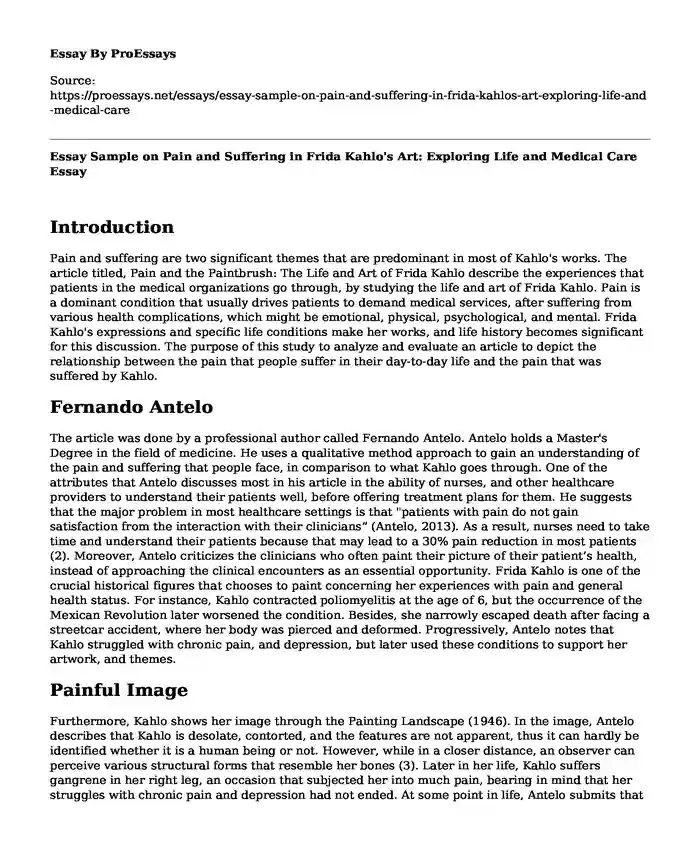Introduction
Pain and suffering are two significant themes that are predominant in most of Kahlo's works. The article titled, Pain and the Paintbrush: The Life and Art of Frida Kahlo describe the experiences that patients in the medical organizations go through, by studying the life and art of Frida Kahlo. Pain is a dominant condition that usually drives patients to demand medical services, after suffering from various health complications, which might be emotional, physical, psychological, and mental. Frida Kahlo's expressions and specific life conditions make her works, and life history becomes significant for this discussion. The purpose of this study to analyze and evaluate an article to depict the relationship between the pain that people suffer in their day-to-day life and the pain that was suffered by Kahlo.
Fernando Antelo
The article was done by a professional author called Fernando Antelo. Antelo holds a Master's Degree in the field of medicine. He uses a qualitative method approach to gain an understanding of the pain and suffering that people face, in comparison to what Kahlo goes through. One of the attributes that Antelo discusses most in his article in the ability of nurses, and other healthcare providers to understand their patients well, before offering treatment plans for them. He suggests that the major problem in most healthcare settings is that "patients with pain do not gain satisfaction from the interaction with their clinicians” (Antelo, 2013). As a result, nurses need to take time and understand their patients because that may lead to a 30% pain reduction in most patients (2). Moreover, Antelo criticizes the clinicians who often paint their picture of their patient’s health, instead of approaching the clinical encounters as an essential opportunity. Frida Kahlo is one of the crucial historical figures that chooses to paint concerning her experiences with pain and general health status. For instance, Kahlo contracted poliomyelitis at the age of 6, but the occurrence of the Mexican Revolution later worsened the condition. Besides, she narrowly escaped death after facing a streetcar accident, where her body was pierced and deformed. Progressively, Antelo notes that Kahlo struggled with chronic pain, and depression, but later used these conditions to support her artwork, and themes.
Painful Image
Furthermore, Kahlo shows her image through the Painting Landscape (1946). In the image, Antelo describes that Kahlo is desolate, contorted, and the features are not apparent, thus it can hardly be identified whether it is a human being or not. However, while in a closer distance, an observer can perceive various structural forms that resemble her bones (3). Later in her life, Kahlo suffers gangrene in her right leg, an occasion that subjected her into much pain, bearing in mind that her struggles with chronic pain and depression had not ended. At some point in life, Antelo submits that Kahlo consistently used alcohol and other substances to relieve her from pain. Eventually, she became an alcohol addict, despite seeking medication for meperidine and morphine (p. 4). After getting obsessed with the medications, which she declared as unproductive, Kahlo decided to go for spinal surgery. She later paints the pain and hardship experiences using an artifact, “The Broken Column” of 1984. Besides, Kahlo shows another painful image in her work titled the Henry Ford Hospital (1932). In this image, Kahlo's image lies on the floor and shows evidence of miscarriage with anatomic structures surrounding the image. She then shares her experiences of the pain during a miscarriage in her work, My Birth (1932), where an observer can see a series of images denoting painful experiences and memories. Funnily, there is no family member nor friend in all of her works to prove that she was getting any form of aid during her painful situations.
Conclusion
In summary, Antelo exceptionally presents a summary of the works done by Frida Kahlo to support the theme of pain and suffering in her entire lifetime, with a series of medical conditions that she experienced in and out of hospitals. Kahlo also uses the painting method to try to relieve herself from pain because there is no person to help her manage the conditions. Therefore, it is imperative that clinicians and all medical professionals understand their patients and offer a pleasant environment that supports their recovery process instead of painting their health status.
Reference
Antelo, F. (2013). Pain and the paintbrush: The life and art of Frida Kahlo. AMA Journal of Ethics, 15(5), 460-465. https://journalofethics.ama-assn.org/article/pain-and-paintbrush-life-and-art-frida-kahlo/2013-05
Cite this page
Essay Sample on Pain and Suffering in Frida Kahlo's Art: Exploring Life and Medical Care. (2023, Sep 25). Retrieved from https://proessays.net/essays/essay-sample-on-pain-and-suffering-in-frida-kahlos-art-exploring-life-and-medical-care
If you are the original author of this essay and no longer wish to have it published on the ProEssays website, please click below to request its removal:
- Understanding Scope of Practice in Relation to Certification and Licensure - Case Study on Nursing
- Contemporary Nursing and Issues Social Issues Paper Example
- Pill Poppers: Film Analysis Essay
- Placebo Theory and Stress Paper Example
- Media and the Fashion World
- Essay Example on Drug Addiction: Diagnosis and Treatment
- Essay Sample on Lessons in Stranger in the Village & Learning to Read and Write







